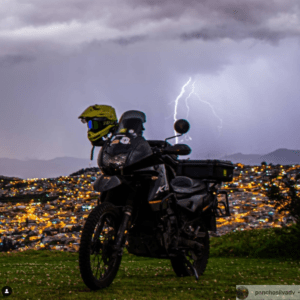Not everyone loves the rain… Honestly, we must admit that Ecuador is one of the best countries to ride a motorcycle all year round. But driving a motorcycle in the rain is something else because we don’t like to get wet. Even if it rains, you have to ride the bike!
Despite the challenges, don’t let rain dampen your trip. Riding in the rain may not be ideal, but it’s manageable. On two wheels, especially on wet surfaces, visibility and traction are reduced, posing greater vulnerability. Exercise caution. Here are four tips for rain riding: wear proper gear, maintain visibility, adjust riding style, and inspect your bike. (Ecuador is one of the best countries to ride a motorcycle all year round. (Even if it rains, you have to ride the bike!). 4 tips for riding a motorcycle in the rain:

Drive the motorcycle according to the intensity and amount of rain.
Adapt motorcycle driving to rainfall intensity, asphalt condition, and grip strength against the force of water on the road. The worst happens when a spark begins and not when it rains hard. In such conditions, water mixes with dirt, creating a slippery layer on the road, posing challenges for riders.
Safety distance in case of rain
Always being at a safe distance at any time with your motorcycle is good and even more so if it is raining. The safest thing is to keep twice the normal distance, about 100 meters, for two reasons: first, to gain time to react well in advance, and second, to prevent the water from rocking the wheels of the car in front.
How to brake in case of rain
If you don’t usually use the rear brake, now is the time to get in the habit. The ideal in these cases is to touch the rear first to contain and then the front to stop. Relying on all the effort on the front caliper is a bit risky, as you can easily lose the front part when locking (low-side the bike). On the other hand, try not to break in the middle of a curve, do it sooner. Anticipate turns, slowing down beforehand to avoid braking or changing direction mid-curve, especially on wet roads.
On days of heavy rain, puddles can overly wet the brake discs and form a liquid layer between the disc and the pad, which acts as a lubricant. In the event of unexpected braking, the braking capacity will be significantly reduced. In addition, the levers have more travel and the touch is very spongy. Repeatedly acting on them as a pump helps them regain the initial touch. Sudden temperature changes, like driving over puddles with hot brake discs, can cause them to bend slightly.
The well-known ABS (Antilock Brake System) prevents the wheels from locking in the event of heavy braking. It consists of a pump incorporated into the brake fluid circuits and some sensors that control the revolutions of the wheels. If one or both wheels suddenly reduce their revolutions during sudden braking, the ABS detects this and interprets that the wheels are about to lock without the vehicle having stopped.
How to prevent the helmet from fogging up?
The difference in temperature between the hot air that we exhale when breathing and the cold outside causes the helmet screen to fog up. This is a serious problem because you will quickly lose your vision and have to lift the screen. To avoid this, it is recommended to open it slightly to allow air to enter, use a pin or a nasal mask.
The pin lock is a small screen with a silicone edge that adheres to the inner surface of the helmet screen, creating a sealed air chamber to prevent fogging. For its part, a nose cover prevents the air that we expel through the nose from hitting the screen, which always causes the screen to fog up. The sum of both elements will greatly minimize the appearance of fogging. The ideal is to use a clear screen, leaving the smoked/tinted ones for the summer since the luminosity with water decreases a lot.
You also have to be careful with the fog from the mirrors, when entering a tunnel it is very easy for them to fog up, for example. These tips will make your ride under the rain a bit safer. Then again, our mission in your tour is for you to enjoy yourself, there’s always a “plan B” to take.
| Visit Us | 4 tips for riding a motorcycle in the rain. | Our website